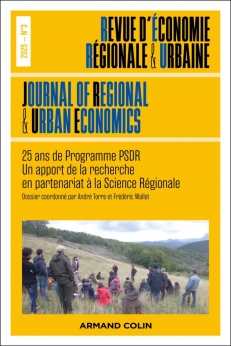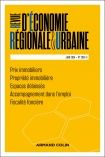
REVUE D'ÉCONOMIE RÉGIONALE ET URBAINE (3/2025)
Pour acheter ce numéro, contactez-nous
Recevez les numéros de l'année en cours et accédez à l'intégralité des articles en ligne.
Résumé L’adoption de pratiques agroécologiques (PAE) constitue une étape majeure pour aller vers une agriculture plus durable. Nous mobilisons le cadre analytique de l’économie de l’innovation et des transitions studies pour explorer les déterminants de l’adoption de 10 PAE. Nous réalisons une analyse économétrique sur une population de 47212 exploitations laitières françaises issues du Recensement Agricole 2010. Les résultats montrent l’importance des caractéristiques structurelles et organisationnelles contribuant au développement des capacités d’absorption telles que la taille, le mode de gouvernance et la gestion des incertitudes dans l’adoption des PAE. Ils mettent également en exergue le rôle incitatif de la réglementation et surtout l’influence majeure des processus territoriaux de proximité géographique. En termes de politique publique et du fait de la forte dynamique territorialisée de l’agriculture, encourager le développement des circuits courts, des espaces locaux d’échanges pourrait favoriser l’adoption des PAE et contribuer à la transition vers une agriculture plus durable.
The adoption of agroecological practices is an important and critical step in the transition to an ecological agri-food sector. The aim of this paper is to explore the determinants of the adoption of these practices on French dairy farms. Using the analytical framework of the economics of innovation and transitions studies, we explore the role of internal (characteristics of the manager, governance and structural characteristics) and external (territorial, market and regulatory characteristics) farm factors in the adoption of 10 agro-ecological practices. The approach is based on an econometric analysis of data from the 2010 French agricultural census and a population of 47212 dairy farms. The results highlight the importance of structural and organizational characteristics such as size, governance and the managerial characteristics, particularly in terms of education and uncertainty management. They show that policies to promote education, diversification of farm activities and the use of ICTs might be beneficial for the development of absorptive, innovative and adaptive capacities fostering farms ecological transition. With regard to external factors, they show the incentive role of regulation and the importance of payment schemes for environmental services. Above all, they highlight the major influence of geographical proximity processes. They underline notably the strong positive impact of the adoption behavior of the neighboring dairy farms on the ecological performance of the farm. From a public policy perspective, and given the strong territorial dynamics of agriculture, encouraging the development of short supply chains and local spaces for exchanging information and knowledge on sustainable agricultural practices could help to promote the adoption of PAE and fostering the transition towards more ecological agriculture.

